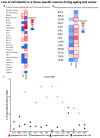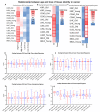Transcriptomic analysis reveals a tissue-specific loss of identity during ageing and cancer
- PMID: 37884865
- PMCID: PMC10604446
- DOI: 10.1186/s12864-023-09756-w
Transcriptomic analysis reveals a tissue-specific loss of identity during ageing and cancer
Abstract
Introduction: Understanding changes in cell identity in cancer and ageing is of great importance. In this work, we analyzed how gene expression changes in human tissues are associated with tissue specificity during cancer and ageing using transcriptome data from TCGA and GTEx.
Results: We found significant downregulation of tissue-specific genes during ageing in 40% of the tissues analyzed, which suggests loss of tissue identity with age. For most cancer types, we have noted a consistent pattern of downregulation in genes that are specific to the tissue from which the tumor originated. Moreover, we observed in cancer an activation of genes not usually expressed in the tissue of origin as well as an upregulation of genes specific to other tissues. These patterns in cancer were associated with patient survival. The age of the patient, however, did not influence these patterns.
Conclusion: We identified loss of cellular identity in 40% of the tissues analysed during human ageing, and a clear pattern in cancer, where during tumorigenesis cells express genes specific to other organs while suppressing the expression of genes from their original tissue. The loss of cellular identity observed in cancer is associated with prognosis and is not influenced by age, suggesting that it is a crucial stage in carcinogenesis.
Keywords: Functional genomics; Geriatric oncology; Geroscience; Oncogenomics.
© 2023. The Author(s).
Conflict of interest statement
JPM is an advisor/consultant for the Longevity Vision Fund, NOVOS, YouthBio Therapeutics and the founder of Magellan Science Ltd, a company providing consulting services in longevity science. GAS, KC and, RAA have no conflicts to declare.
Figures




Similar articles
-
A human tissue-specific transcriptomic analysis reveals a complex relationship between aging, cancer, and cellular senescence.Aging Cell. 2019 Dec;18(6):e13041. doi: 10.1111/acel.13041. Epub 2019 Sep 27. Aging Cell. 2019. PMID: 31560156 Free PMC article.
-
Inter-tissue convergence of gene expression during ageing suggests age-related loss of tissue and cellular identity.Elife. 2022 Jan 31;11:e68048. doi: 10.7554/eLife.68048. Elife. 2022. PMID: 35098922 Free PMC article.
-
Ageing-associated changes in the expression of lncRNAs in human tissues reflect a transcriptional modulation in ageing pathways.Mech Ageing Dev. 2020 Jan;185:111177. doi: 10.1016/j.mad.2019.111177. Epub 2019 Nov 9. Mech Ageing Dev. 2020. PMID: 31706952 Free PMC article.
-
Gene expression hallmarks of cellular ageing.Biogerontology. 2018 Dec;19(6):547-566. doi: 10.1007/s10522-018-9750-z. Epub 2018 Feb 28. Biogerontology. 2018. PMID: 29492790 Free PMC article. Review.
-
Single-cell omics in ageing: a young and growing field.Nat Metab. 2020 Apr;2(4):293-302. doi: 10.1038/s42255-020-0196-7. Epub 2020 Apr 20. Nat Metab. 2020. PMID: 32694606 Review.
Cited by
-
A cellular identity crisis? Plasticity changes during aging and rejuvenation.Genes Dev. 2024 Oct 16;38(17-20):823-842. doi: 10.1101/gad.351728.124. Genes Dev. 2024. PMID: 39293862 Free PMC article. Review.
-
An overview of contemporary theories of ageing.Nat Cell Biol. 2025 Jul;27(7):1074-1082. doi: 10.1038/s41556-025-01698-7. Epub 2025 Jul 1. Nat Cell Biol. 2025. PMID: 40595368 Review.
-
Age and early life adversity shape heterogeneity of the epigenome across tissues in macaques.bioRxiv [Preprint]. 2025 Jul 18:2025.07.13.664445. doi: 10.1101/2025.07.13.664445. bioRxiv. 2025. PMID: 40791500 Free PMC article. Preprint.
-
FEAtl: a comprehensive web-based expression atlas for functional genomics in tropical and subtropical fruit crops.BMC Plant Biol. 2024 Sep 30;24(1):890. doi: 10.1186/s12870-024-05595-3. BMC Plant Biol. 2024. PMID: 39343895 Free PMC article.
-
A comprehensive map of the aging blood methylome in humans.Genome Biol. 2024 Sep 6;25(1):240. doi: 10.1186/s13059-024-03381-w. Genome Biol. 2024. PMID: 39242518 Free PMC article.
References
MeSH terms
Grants and funding
LinkOut - more resources
Full Text Sources
Medical

